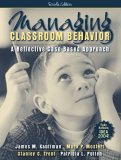Managing Classroom Behavior
By Murray Bourne, 19 Dec 2005
"A Reflective Case-based Approach"
© Kauffman, J. et al, 2006

Summary Review
Teaching ain't easy - you could almost say that a good teacher requires super-human talents.
Included in those talents is the ability to control classroom behaviour. All students in a class need to have a safe environment where they can get on with the learning.
The paperback Managing Classroom Behaviour is based on some very sound educational principles. I like the fact that each chapter starts with a set of questions, so that the reader is immediately engaged with the topic. From the preface:
... our approach is based on the assumptions that asking good questions is a prerequisite for finding good answers... (p. x)
I also like the writers' holistic view of behaviour problems, and the encouragement to analyse behavioural problems from many angles (including the all-important one - are they misbehaving because the lesson is boring?).
The case studies used in the book are realistic, having been derived from the experiences of several practicing teachers.
The multitude of excellent questions throughout the book could be used for discussion in professional development seminars.
Some of the chapters include advice on talking to students, using peer influence (very powerful), and addressing our own prejudices.
The second half of the book consists of 21 well-written case studies, involving all sorts of difficult classroom scenarios. There are no "solutions" provided for these difficulties - the reader is encouraged to apply the analysis from the first half of the book.
I recommend this book for those who are struggling with behavioural issues in their classrooms. And let's face it, that would be most of us, wouldn't it?
Footnote: This book has a different approach to Dunn's Dos and Dont's of Behaviour Management (see my summary review. Compared to the writers of Managing Classroom Beavior, Dunn is a "survivor" and has more of a "us and them" mentality. Dunn also tends to write in the "if they do this, then do that" approach. There is a lot to gain from both books, however.
Be the first to comment below.